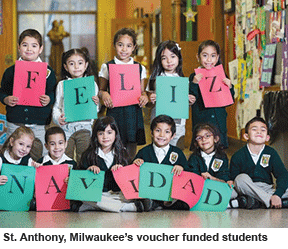 On the desk of Zeus Rodriguez, the president of St. Anthony School in Milwaukee, a mini Republican primary is under way. A signed photograph of Scott Walker, the governor of Wisconsin, competes for space with snaps of Rand Paul and Jeb Bush — all three of them presidential hopefuls. St. Anthony’s is popular among conservatives because it has more pupils taking advantage of government-funded vouchers than any other private school in America.
On the desk of Zeus Rodriguez, the president of St. Anthony School in Milwaukee, a mini Republican primary is under way. A signed photograph of Scott Walker, the governor of Wisconsin, competes for space with snaps of Rand Paul and Jeb Bush — all three of them presidential hopefuls. St. Anthony’s is popular among conservatives because it has more pupils taking advantage of government-funded vouchers than any other private school in America.
The local neighbourhood was once populated by German and Polish Catholics but is now home to the Hispanics. Almost all pupils speak Spanish at home; most are also poor. Yet 95 percent of the first two classes of high school students from St. Anthony’s have graduated and more than 90 percent have gone on to college. All this, for a cost to taxpayers of just $7,500 (Rs.4.71 lakh) per pupil; Milwaukee’s public schools, by contrast, spend a whopping $13,000 (Rs.8.1 lakh) per pupil.
All told, 10 percent of American children attend some sort of private school. Pupils at such schools are typically well off, but most of the change is taking place lower down, thanks to vouchers aimed at poor kids in pathetic public schools. If these programmes are expanded, America will look a bit more like Japan or the Netherlands, where private schools serve lots of hard-up families and children do better in exams than Americans.
No two voucher schemes are alike, which makes comparing them difficult. Ohio alone has five, all with different criteria for eligibility. Most began as schemes to help families in predominantly black neighbourhoods with failing schools find something better, and were then extended to children in foster care and those with special needs. Only now are they being extended to families wealthy enough that they might have sent their children to low-cost private schools anyway.
Some states use tax credits to reimburse parents for private tuition. Others give tax breaks to people who donate to charities which fund scholarships at private schools (which gets around the Blaine amendment). Florida has a scheme like this: though the state has no personal income tax, tax-deductible corporate donations fund 60,000 places for children in private schools.
Wisconsin’s education department has commissioned evaluations over the past 25 years which, controlling for race, income and sex, found the test scores of children at private schools are no better than those who stayed in the public school system. This is consistent with the federal government’s evaluation of the voucher scheme for poor parents in bad school districts in Washington, DC, which found no statistical difference between children given vouchers and those who were not, in reading and maths.
However, this is not the end of the story for vouchers. In both Milwaukee and Washington, voucher schemes get similar results to public schools but with much less money. Under the DC scheme, each voucher is worth $8,500 (Rs.5.3 lakh) a year, compared with $17,500 (Rs.10.3 lakh) to educate a child in the public school system. In Milwaukee, the difference is smaller but still amounts to several thousand dollars. Another consistent finding from voucher schemes is that parents like being given a choice, which explains why vouchers, once granted, are hard to take away.
(Excerpted and adapted from )